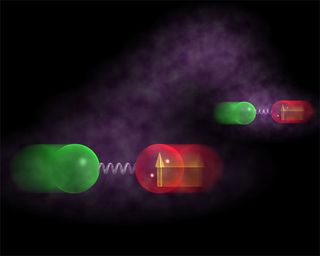
The weird way entangled particles stay connected even when separated by large distances — a phenomenon Albert Einstein called "spooky" — has been confirmed once again, this time with a key loophole in the experiment eliminated.
The results from the new experiment confirm one of the wildest predictions of quantum mechanics: that a pair of "entangled" particles, once measured, can somehow instantly communicate with each other so that their states always match.
"Quantum mechanics is a wonderful theory that scientists use very successfully," said study co-author Marissa Giustina, a physicist at the University of Vienna. "But it makes some strange predictions." [How Quantum Entanglement Works (Infographic)]
But the new experiment goes further than past studies by eliminating one of the major loopholes in entanglement experiments.
The findings were published April 14 in the journal Nature.
Spooky phenomenon
Since the 1930s, physicists have been troubled by some of the bizarre implications of quantum mechanics. Namely, when they measured the wave orientation of a particle, such as a photon, as horizontal, its entangled partner would have a correlated orientation— such as an opposite, vertical orientation — at the same instant.
Sign up for the Live Science daily newsletter now
Get the world’s most fascinating discoveries delivered straight to your inbox.
The implications were that individual entangled particles don't exist in a particular state until they are measured, and that, once measured, the particles could somehow communicate their state to each other at a rate faster than the speed of light — which seemed to violate Einstein's theory of relativity. (Recent research suggests the entangled particles interact at a speed that's 10,000 times faster than the speed of light.)
In a 1935 paper, Einstein and his colleagues noted that one way to get around spooky action at a distance would be to assume that each particle always traveled with some hidden knowledge of the other's state before the particles were measured.
But in 1964, Irish physicist John Stewart Bell proposed a mathematical way to check whether hidden variables or weird non-locality (the idea that entangled particles can communicate faster than the speed of light) explained the behaviors. Since then, scientists have used Bell's tests to demonstrate non-locality.
But all of these tests relied on three assumptions, or loopholes: that the source of the photons and the detector weren't somehow communicating, that the photon detectors weren't communicating, and that the particles physicists measured were representative of the ones that they didn’t measure. If any of the assumptions was wrong, in theory, the hidden-variables explanation could still be right.
Better detector
For the current study, Giustina and her colleagues redid the experiment with entangled photons, or particles of light. This time, however, they didn't have to rely on the assumption that the photons they caught were representative of the ones that got away.
The physicists were able to eliminate the loophole using a different version of Bell’s check so that it didn't require an assumption of fair sampling. They also eliminated the loophole by catching many more photons using ultrasensitive, superconducting photon detectors kept near absolute zero. Every time a photon hit the detector, it caused an increase in the electrical resistance to current.
And although most physicists now accept the strange laws of quantum mechanics, the new experiment makes it even harder to claim that hidden variables — those yet to be dreamed up by scientists — explain particles' strange behavior.
Follow Tia Ghose on Twitter @tiaghose. Follow LiveScience @livescience, Facebook & Google+. Original article on LiveScience.com.

Tia is the managing editor and was previously a senior writer for Live Science. Her work has appeared in Scientific American, Wired.com and other outlets. She holds a master's degree in bioengineering from the University of Washington, a graduate certificate in science writing from UC Santa Cruz and a bachelor's degree in mechanical engineering from the University of Texas at Austin. Tia was part of a team at the Milwaukee Journal Sentinel that published the Empty Cradles series on preterm births, which won multiple awards, including the 2012 Casey Medal for Meritorious Journalism.